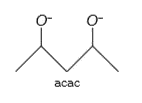The anion of actylacetone (acac) forms Co(acac)3 chelate with Co3+ . The rings of the chelate are
A
Five membered
B
Four membered
C
Six membered
D
Three membered
Video Solution
Text Solution
The correct Answer is:C
The anion of acetylacetone (acac) is a bidentate ligand.

So (acac)3 will form a 6 membered chelate ring with Co3+
|
Updated on:21/07/2023
Topper's Solved these Questions
- BOOK - ERRORLESSCHAPTER - COORDINATION COMPOUNDSEXERCISE - ASSERTION AND REASON7videos
COORDINATION COMPOUNDS
- BOOK - ERRORLESSCHAPTER - COORDINATION COMPOUNDSEXERCISE - NCERT BASED QUESTION (ORGANOMETALLIC COMPOUNDS)13videos
COORDINATION COMPOUNDS
- BOOK - ERRORLESSCHAPTER - CHEMISTRY IN EVERYDAY LIFE EXERCISE - Assertion & Reason4videos
CHEMISTRY IN EVERYDAY LIFE
- BOOK - ERRORLESSCHAPTER - ELECTROCHEMISTRYEXERCISE - Assertion & Reason11videos
ELECTROCHEMISTRY
Similar Questions
Knowledge Check
- Question 1 - Select One
Which of the following does not form a chelate ?
AEDTABOxalateCNH3DEthylenediamine - Question 2 - Select One
Which one of the following ligands form a chelate ?
AAcetateBOxalateCAmmoniaDCyanide - Question 3 - Select One or More
Which can form chelates?
AEthylene diamineBOxalateCGlycinateDCyanide
Assertion. Glycine forms a chelate with Cu2+ ion.
Reason. Glycine is a bidentate ligand and thus forms a closed ring structure with the metal ion.View SolutionWhich one of the following ligands form a chelate complex ?
View SolutionWhich one of th efollowing does not form a chelate with oxalate ion by reacting in aqueous solution ?
View SolutionWhich of the following ligands forms chelate with metal ion?
View SolutionStatement-1:In natural tris chelating complex, [Co(acac)3], in each ring the two M−O bonds are equal in length, as are two C-O and the two C-C bonds because.
Statement-2:In each ring resonance take place.View Solution

